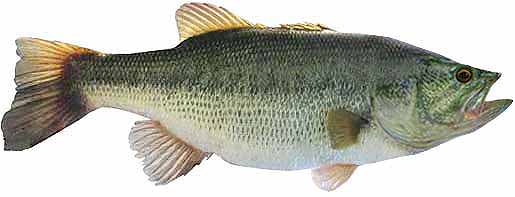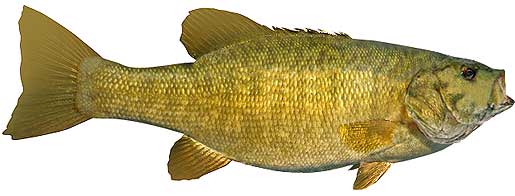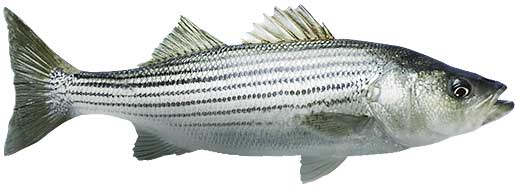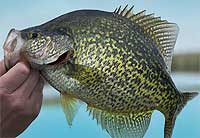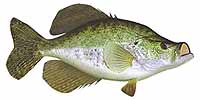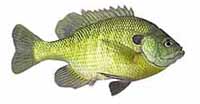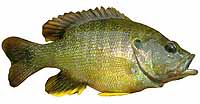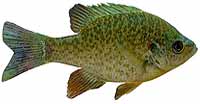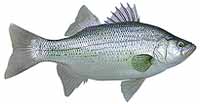Fishing Report For Lake Murray, OK
By Rick Seaman
Last updated on .
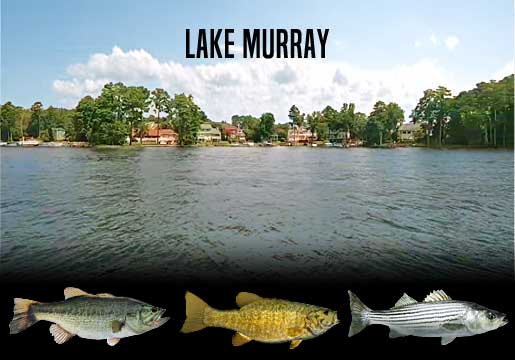
Fishing Reports
Popular Fish Species Lake Murray, OK
Largemouth Bass
Current Report: Fair To Good
Largemouth grow to the biggest size of the three species of black bass in Lake Murray. Bassmaster reports an average of over 5 pounds per fish was required to win numerous Murray events.
FALL. Now that Fall has arrived, bass here have moved shallow, following schools of baitfish into coves and shallow bays around 6 to 18 feet of water. Currently topwater, jerkbaits, crankbaits, and slow-rolled spinnerbaits are catching most of the bass. Later in Fall, as deeper water cools, bait and bass move out to ledges, channel edges, points and humps where flutter spoons, jigs and drop shots are often good choices in 10 to 25 feet of water.
WINTER. Winter will isolate largemouth around slightly deeper structure, flats, points and creek channels. They can be found from 15 to 30 feet deep. Here they hold, feeding less frequently, awaiting warmer water to return in Spring. Slow presentations are key to getting bites. On warmer days, especially during late afternoons, bass may move into 8 to 12 feet of water to feed.
SPRING. Once water temperatures rise into the low 60's, largemouth will move from deep wintering holes, to shallower water nearby spawning areas. Vibrating jigs, jerkbaits and spinnerbaits typically get bites just away from the shoreline. At this time they are feeding aggressively in about 2 to 12 feet of water, and preparing for the spawn. Once water warms into the mid to high 60's, they will move into 2 to 4 feet of water, and create nests, then lay their eggs. Immediately afterwards, females move to deeper water and males remain to guard the eggs, and then the fry. After a couple weeks, the males also move to slightly deeper water. Deep-diving crankbaits, vibrating jigs, plastic worms and swimbaits are catching bass during this period.
SUMMER. Water temperatures will warm considerably in Summer. Bass will feed shallow, early and late in the day, where they will be caught in 8 to 15 feet of water, on crankbaits and spinnerbaits. Wacky-rigged stick worms always catch finicky bass when the bite is slow. Largemouth bass here feed on shad, herring, small sunfish and crawfish. During the hotter parts of the day, they are being caught on points, channel edges, and ledges 15 to 35 feet deep.
Smallmouth Bass
Current Report: Good
FALL. Lake Murray is also considered a pretty decent smallmouth bass fishery. Fall is here and smallmouth are following schools of baitfish into coves and bays 6 to 18 feet deep. They thrive in the cold, clean water, which is an ideal environment for them. Locals report that tube jigs are a great choice when the bass are around 15 feet deep. Drop shot rigs with small worms or shad shaped plastics are also popular in 10' water or deeper. Jerkbaits, deep-diving crankbaits, and slow-rolled spinnerbaits, are also successful, when bass are shallow to mid depth. Later in Fall, smallies move to slightly deeper water, around 10 to 25 feet deep. Fishing shallow for smallmouth is often good on cold, windy, cloudy and rainy days.
WINTER. Winter will isolate them around deeper structure, points, flats and creek channels, often suspending in open water above these features. They can generally be found from 15 to 30 feet deep. Jigging spoons, tube baits, drop-shot worms, jigs and Ned rigs tend to temp smallmouth in deep water. I like to work these deeper haunts very slowly, as the bass are somewhat sluggish. Here they hold, feeding less frequently, awaiting warmer water to return in Spring.
SPRING. After ice out, when water temperatures rise into the 50's, smallmouth move from deep wintering spots to shallower water, just outside spawning areas. They feed heavily in 3 to 10 feet of water at this time, and are typically caught on jerkbaits, crankbaits, tube baits, Ned rigs, and crayfish imitating plastics. Once water warms into the high 50's, they move into shallower water, and create nests in gravel or sand areas, then lay their eggs. Females then move to deeper water and males remain to guard the eggs, and then the fry. After a couple weeks, the males also move into 8 to 18 feet deep, and feed aggressively. Crankbaits, tube baits, Ned rigs, plastic worms, spoons and swimbaits are catching smallies during this period.
SUMMER. Smallmouth bass are currently feeding shallow early and late in the day in 10 to 12 feet of water. They are being caught on crankbaits, swimbaits, Ned rigs and tube baits. Smallmouth bass here feed on crawfish, threadfin shad, blueback herring, gizzard shad, and small sunfish. They prefer rocky or gravel bottom areas, as this is where crayfish live. During the hotter parts of the day, they are being caught on points, humps, and ledges around 25 to 30 feet deep. Often these deeper fish tend to school, so finding them can deliver some fast action. Anglers fishing around the mid-lake channel edges, report good catches during the hot months.
Striped Bass
Current Report: Good
FALL. In Fall, stripers return to shallower water. Early in the day stripers chase bait to the surface and feed aggressively, making this an excellent time for topwater action. They follow schools of bait, which are hanging out in 8 to 20 feet of water. Locals report fishing with live bait is a primary method for catching striped bass at Lake Murray. Carolina rigs with a heavy weight, and a 3 ' to 4' leader, make an ideal setup for live bait. Look for shallow water nearby deeper river channels, and fish them thoroughly. Most any lure that resembles shad will catch striped bass at this time of year. Late Fall will find most of the stripers in 15 to 30 feet of water.
WINTER. In Winter, stripers again hang out in deeper water and feed close to the bottom, often as deep as 40 feet. Warm, sunny afternoons occasionally draw stripers shallower, to around 20 feet deep as they feed on roaming schools of threadfin shad and gizzard shad. The main lake basin, along deep channels is holding schools of stripers, especially in the section of lake around the dam. Locate schools of bait, then look for stripers close by. Fish finders, and forward facing sonar, are a big help in locating these roaming schools. Nice stripers are caught while drift fishing with live bait or cut bait. Spoons, blade baits, and heavy hair jigs are also effective this time of year. Due to the stripers slower metabolism this time of year, anglers are triggering more strikes by working baits more slowly.
SPRING. Water temperatures are return to the mid 60's, and that's ideal for the stripers to spawn. In Spring, work the upper end of the lake, and the backs of coves, where there is inflowing water. If they spawn, this is where they will lay eggs in the moving water. They also move into transition zones on the main lake, in 5 to 15 feet of water, feeding on baitfish which are moving toward the shallows. Expect to locate them on mid-depth ledges, flats or points.
SUMMER. Summer months are the ideal time to chase striped bass here. These stripers hang out in deeper water during the heat of the day, 15 to 30 feet deep, early in the season. Much of the time they are holding over deeper, open water. Morning often draws the stripers shallower, so look for them around the 10-foot range as they feed on roaming schools of baitfish. Being successful at fishing for stripers in Summer is a matter of locating schools of bait, and the wolf packs of stripers are likely to be nearby. Later in Fall, expect to locate schools 20 to 40 feet deep. Fish finders, and sonar electronics, are a big help in locating these roaming schools. Nice stripers are being caught while trolling or drift fishing. Spoons, blade baits, crankbaits, live bait and cut bait are all effective here.
Fishing Video
Fish species to fish for...
Guide to fishing for largemouth bass, smallmouth bass, spotted bass, channel catfish, black crappie, white crappie, walleye, bluegill, green sunfish, redear sunfish, white bass and striped bass at Lake Murray in Oklahoma.
 Lake Murray is a 6,400-acre lake 95 miles of shoreline, located in the south-central part of the state. The most sought after species include three species of black bass and striped bass. Other options include white bass, black crappie, white crappie, sunfish, catfish and walleye.
Lake Murray is a 6,400-acre lake 95 miles of shoreline, located in the south-central part of the state. The most sought after species include three species of black bass and striped bass. Other options include white bass, black crappie, white crappie, sunfish, catfish and walleye.
Primary fish species to catch
Click images for fishing tips and details about each species.
Today's Weather & Forecast
Fishing Boat Rentals
Click here for fishing boat rentals.
Public Boat Launch Ramps & Landings
Click here for boat ramps.
Marinas
Click here for marinas.
Fishing License
Click here for a Oklahoma Fishing License.
Map - Fishing & Access
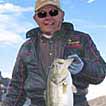 Rick Seaman is a fishing enthusiast with over five decades of fishing experience, a retired tournament fisherman, author of numerous published articles on fishing, and co-author of the book "Bass Fishing - It's not WHAT you throw, It's WHERE you throw it".
Rick Seaman is a fishing enthusiast with over five decades of fishing experience, a retired tournament fisherman, author of numerous published articles on fishing, and co-author of the book "Bass Fishing - It's not WHAT you throw, It's WHERE you throw it".
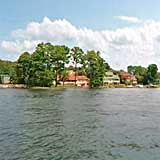 Contact Information
Contact Information
Lake Murray Marina
8424, 3315 Lodge Rd
Ardmore, OK 73401
580 223-9339
Fishing lakes in each state
102825
Lake Murray, Oklahoma Report
OKLAHOMA


Information about fishing lakes in Oklahoma
Lake Murray offers bass, striped bass, white bass, crappie, sunfish, catfish and walleye fishing in south-central Oklahoma.


